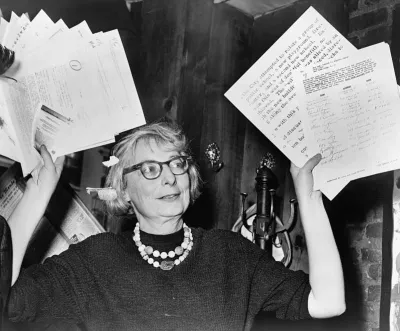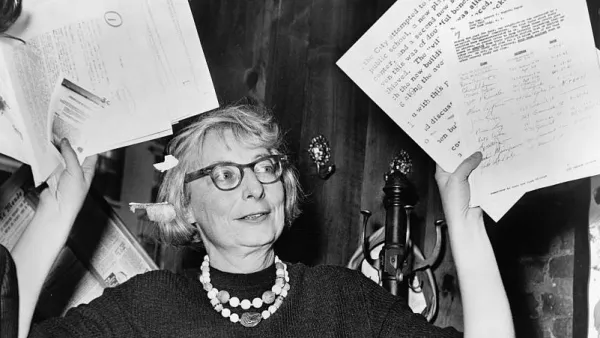The iconic urban thinker has influenced generations of planners, but how do her ideas hold up in an age of massive upheaval and economic inequality?

Writing in Urban Omnibus, Jennifer Hock, Nathan Storring, and Samuel Zipp take stock of the legacy of the so-called "patron saint of city planners," that powerful voice for neighborhood-level urbanism, Jane Jacobs.
While Jacobs' observations on the qualities of vibrant neighborhoods once served as the paragon of urbanist ideals, recently some critics have argued that her ideas are "a relic" that has been "rendered useless in a time of huge-scale urban and global problems." The building blocks she wrote about have become codified "lifestyle amenities for real estate boosterism, instruments of accumulation in the quivers of urban developers" that are created and manipulated to sell high-priced properties to those who can afford them. Whereas Jacobs relentlessly believed in the power of cities as "decentralized, dynamic, always unpredictable human system[s]," activists today argue that too many aspects of "good" urbanism have been captured by "the forces of neoliberalism."
Her failure to address the role of race in urban politics and policies remains a glaring blind spot in her work, but Hock argues that her ideas remain relevant in helping readers understand how to observe and appreciate their city. "We need to bring Jacobs into the 21st century by placing her in dialogue with writers who have thought deeply about the ways in which racism is implicated in the 'sidewalk ballet.'" Saint Jane's ideas may, in some instances, be outdated or myopic, but her clear-eyed observations of city life and emphasis on small-scale decision making and civic duty continue to offer valuable lessons for today's urbanists.
FULL STORY: What About Jane?

National Parks Layoffs Will Cause Communities to Lose Billions
Thousands of essential park workers were laid off this week, just before the busy spring break season.

Retro-silient?: America’s First “Eco-burb,” The Woodlands Turns 50
A master-planned community north of Houston offers lessons on green infrastructure and resilient design, but falls short of its founder’s lofty affordability and walkability goals.

Delivering for America Plan Will Downgrade Mail Service in at Least 49.5 Percent of Zip Codes
Republican and Democrat lawmakers criticize the plan for its disproportionate negative impact on rural communities.

Test News Post 1
This is a summary

Test News Headline 46
Test for the image on the front page.

Balancing Bombs and Butterflies: How the National Guard Protects a Rare Species
The National Guard at Fort Indiantown Gap uses GIS technology and land management strategies to balance military training with conservation efforts, ensuring the survival of the rare eastern regal fritillary butterfly.
Urban Design for Planners 1: Software Tools
This six-course series explores essential urban design concepts using open source software and equips planners with the tools they need to participate fully in the urban design process.
Planning for Universal Design
Learn the tools for implementing Universal Design in planning regulations.
EMC Planning Group, Inc.
Planetizen
Planetizen
Mpact (formerly Rail~Volution)
Great Falls Development Authority, Inc.
HUDs Office of Policy Development and Research
NYU Wagner Graduate School of Public Service




























